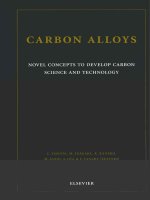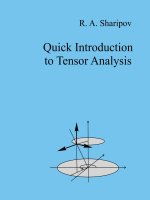harre - cognitive science - a philosophical introduction (sage, 2002)
Bạn đang xem bản rút gọn của tài liệu. Xem và tải ngay bản đầy đủ của tài liệu tại đây (1.83 MB, 337 trang )
cognitive science
a philosophical introduction
Prelims 4/1/2 5:39 pm Page i
Prelims 4/1/2 5:39 pm Page ii
cognitive science
cognitive science
a philosophical introduction
Rom Harré
SAGE Publications
London • Thousand Oaks • New Delhi
Prelims 4/1/2 5:39 pm Page iii
© Rom Harré 2002
First published 2002
Apart from any fair dealing for the purposes of research or
private study, or criticism or review, as permitted under the
Copyright, Designs and Patents Act, 1988, this publication
may be reproduced, stored or transmitted in any form, or by
any means, only with the prior permission in writing of the
publishers, or in the case of reprographic reproduction, in
accordance with the terms of licences issued by the Copyright
Licensing Agency. Inquiries concerning reproduction outside
those terms should be sent to the publishers.
SAGE Publications Ltd
6 Bonhill Street
London EC2A 4PU
SAGE Publications Inc
2455 Teller Road
Thousand Oaks, California 91320
SAGE Publications India PVT Ltd
32, M-Block Market
Greater Kailash – 1
New Delhi 110 048
British Library Cataloguing in Publication data
A catalogue record for this book is available from
the British Library
ISBN 0 7619 6807 5
ISBN 0 7619 6808 3 (pbk)
Library of Congress Control Number: 2001132950
Typest by Photoprint, Torquay, Devon
Printed in Great Britain by The Cromwell Press,
Trowbridge, Wiltshire
Prelims 4/1/2 5:39 pm Page iv
Contents
List of illustrations xiv
List of abbreviations xv
Preface xvii
Acknowledgements xviii
How to use this book in the classroom xix
The nature and methods of science 1
A science for psychology 5
What is the domain of cognitive science? 5
What makes a study program scientific? 8
Learning Point: What is Science? 9
Philosophy in the context of science 9
Some other terms for presuppositions 11
Learning Point: What is Philosophy? 12
Ontology: presuppositions as to what there is 12
Learning Point: Ontology 15
Science, philosophy and psychology in history 15
The project of a scientific psychology in full 16
Conclusion 17
contents
v
part one
chapter one
Prelims 4/1/2 5:39 pm Page v
The natural sciences 19
The world of the natural sciences 20
Learning Point: The World of the Natural Sciences 23
Rival interpretations of science 24
Learning Point: Positivism and Realism 29
Indirect experiments: testing hypotheses about the unobservable 30
Learning Point: Experimenting in Region Three 32
Conclusion 33
Understanding scientific method 35
Describing and Classifying 36
The role of concepts in classification 36
Hierarchical classification systems 37
The bases of type distinctions 38
Learning Point: 1: Describing and classifying 41
Explaining 42
Models 42
Analytical and explanatory uses of models 44
The cognitive foundations of model building 48
Assessing the worth of models 50
Experimental apparatus as model worlds 51
Further uses of modeling 52
Learning Point: 2: Model making 54
Conclusion 54
vi
CONTENTS
chapter three
chapter two
section one
section two
Prelims 4/1/2 5:39 pm Page vi
The search for a science of human behavior 59
Psychology as the science of mental substances 65
Descartes’s psychology 65
The psychology of John Locke 68
The realist psychology of David Hartley 71
The positivist psychology of David Hume 72
Causes and agents: the transcendental solution 73
Learning Point: The Search for a Scientific Psychology 1:
Mental substances 75
Conclusion 76
Psychology as a science of material substances 79
Ontological materialism 81
Methodological materialism 83
Conceptual materialism 85
The arguments for eliminative materialism 86
The arguments against eliminative materialism 87
Psychology cannot do without the person 89
Learning Point: The Search for a Scientific Psychology 2:
Materialism 90
vii
CONTENTS
part two
chapter four
chapter five
section one
section two
section three
Prelims 4/1/2 5:39 pm Page vii
Psychology as a branch of biology 91
Aristotelian beginnings: psychology as the science of
goal-directed action 92
The modern Aristotelians 95
Evolutionary psychology 96
Learning Point: The Search for a Scientific Psychology 3: Biologism 100
Conclusion 101
The beginnings of cognitive science 103
The First Cognitive Revolution 105
Early attempts at devising a cognitive machine 106
Learning Point: Sources of the First Cognitive Revolution 109
The second attempt: computing machines 109
Using artificial intelligence models in psychology 112
Sources of artificial intelligence models 113
Learning Point: The Projects of Artificial Intelligence 115
Strengths and weaknesses of the First Cognitive
Revolution 116
The troubling questions 117
The representation of intentionality 118
Global aspects of linguistic meaning 123
Learning Point: The Problem of Intentionality 124
The representation of normativity 125
Problems with a rule-based psychology 125
Learning Point: Can Normativity be Represented? 129
Conclusion 130
viii
CONTENTS
section four
section one
chapter six
section two
Prelims 4/1/2 5:39 pm Page viii
Towards a scientific psychology 137
Grammar and cognition 141
Symbols and their meanings 142
The central role of language 143
The domain of psychology: the act–action distinction 146
The grammars of everyday life 147
The intentional stance 150
Skill 151
Meta-discourses or ‘human sciences’ 152
Positioning: the moral dimension 154
The ontology of persons 154
‘Mind–body’ ties: three links between P, O and M discourses 156
Psychology as a hybrid science 162
Learning Point: Discursive Psychology: The Presuppositions 165
Conclusion 166
Cognitive science: the analytical phase 169
Cognitive tasks and symbolic tools 169
Reinterpreting experiments 170
Two worked examples 176
Grammar as a research tool 181
Learning Point: From a Causal to a Normative Metaphysics 186
Conclusion 187
ix
CONTENTS
part three
chapter seven
chapter eight
Prelims 4/1/2 5:39 pm Page ix
Connectionism and the brain 189
What is a connectionist system? 191
Neurons and nets 191
Model nets as research tools 197
Strokes and other lesions 200
Problems with the brain structure :: model net analogy 200
Learning Point: Connectionism and Parallel Distributed
Processing 202
The brain as an organ for performing cognitive tasks 203
The anatomy of the human brain 204
The physiology of the human brain 204
Negative correlations: aphasias and brain damage 206
Positive correlations: scanning technology 207
Learning Point: Artificial Nets and Real Brains 209
Conclusion 210
Cognitive science in action 215
The memory machine 221
The vernacular vocabulary of remembering 222
What can be remembered? 223
The problem of authentication 225
x
CONTENTS
chapter nine
section one
section two
part four
chapter ten
section one
Prelims 4/1/2 5:39 pm Page x
Remembering as a topic for cognitive psychology 226
Neisser’s paradox and the Ebbinghaus paradigm 227
The problem of the workings of memory machines 229
Generic models: representation and retention 229
The research program summarized 230
Cognitive psychology of remembering, phase one:
a descriptive taxonomy 232
Collective remembering 233
Individual remembering 234
Learning Point: Remembering: Vocabularies and Classifications 237
Cognitive psychology of remembering, phase two:
explanation 238
Some important metaphors 238
Models for the psychology of remembering 239
Transforming a cognitive model into an artificial intelligence
simulation 244
Worked example: the hippocampus 246
Learning Point: Models for Remembering 251
Conclusion 252
The psychology of classifying 255
The Aristotelian logic of classification 255
The expression and representation of bodies of knowledge 258
Learning Point: Basic Principles of Knowledge Representation 260
Alternative conceptions of a knowledge base 261
Problems common to all approaches to knowledge engineering 264
Limitations of the project so far 265
xi
CONTENTS
section two
section three
section four
chapter eleven
Prelims 4/1/2 5:39 pm Page xi
Cognitive psychology of classifying: take one 266
Cognitive psychology of classifying: take two 268
Learning Point: Alternative Methods of Classification 270
Connectionism: the way forward? 270
Exercise: extracting a prototype 271
Disadvantages with connectionist models 272
Neuropsychology of classifying 273
Learning Point: Connectionist Models of Classifying 274
Conclusion 274
Cognitive disorders 277
Presuppositions of psychiatry and clinical psychology 278
The expansion of the domain of psychopathology 280
Bizarre thought patterns and disordered brains 282
The presupposition of psychotherapy 283
Classifying phenomena and modeling the unobservable 285
Learning Point: Sources of Concepts of Psychopathology:
Deviance and Unacceptability 286
Defects of discourse 287
Non-standard story lines using standard syntax 287
Non-standard syntax and standard narrative conventions 288
Learning Point: Psychopathology as Improper Narration 291
Psychopathology and brain malfunction 291
The insertion of an old trouble into the Hybrid Psychology
framework 292
The creation of a new mental illness: the case of attention
deficit hyperactivity disorder 294
xii
CONTENTS
chapter twelve
section one
section two
section three
Prelims 4/1/2 5:39 pm Page xii
Contesting a grammar: the case of chronic fatigue syndrome 296
Learning Point: The Transformation, Invention and Contesting
of Mental Illnesses 297
Conclusion 298
Epilog 303
References 305
Name index 311
Subject index 312
xiii
CONTENTS
Prelims 4/1/2 5:39 pm Page xiii
List of illustrations
3.1 Tree representation of a classificatory system 38
3.2 Taxonomic hierarchy 41
3.3 Type hierarchy of material things 50
6.1 TOTE machine for hammering home nails 107
9.1 Basic structure of real nerve cell 192
9.2 Synapse in detail 192
9.3 Migration of sodium and potassium ions 193
9.4 Structure of an artificial neuron 194
9.5 Threshold function 194
9.6 Sigmoid function 194
9.7 Connectionist neural net 195
9.8 From real net to model net 196
9.9 Hinton diagram of the pattern associator 197
9.10 Untrained net 199
9.11 Untrained weight matrix 199
9.12 Weights in a trained net 200
9.13 A median section of the brain showing the location of the
hippocampus 205
10.1 Summary taxonomy of ‘remembering’ concepts 237
10.2 Connections with the hippocampus 247
10.3 Forward connections from areas of cerebral association neocortex
to the hippocampus 249
10.4 A neural network simulation of the hippocampus 250
10.5 An eight-unit auto-associator 250
11.1 A Porphyry Tree 256
12.1 Boundary fixing 281
xiv
Prelims 4/1/2 5:39 pm Page xiv
List of abbreviations
ADHD attention deficit hyperactivity disorder
AI artificial intelligence
ASCII American Standard Code for Information Interchange
CFS chronic fatigue syndrome
CNS central nervous system
EEG electroencephalograph
GOFAI good old-fashioned artificial intelligence
IPS information-processing system
PDP parallel distributed processing
PET positron emission tomography
SSH symbol system hypothesis
T/T task/tool
TOTE test/operate/test/exit
TPP Taxonomic Priority Principle
xv
Prelims 4/1/2 5:39 pm Page xv
Prelims 4/1/2 5:39 pm Page xvi
Preface
This book is based on the Machette Lectures, delivered at the University
of Ohio, Athens OH in March 1998. It gives me great pleasure to
acknowledge the generous support of the Machette Foundation for the
lecture series and its subsequent publication. I am particularly grateful to
the Philosophy Department of Ohio University at Athens OH for invit-
ing me and for providing such a rewarding and stimulating environment
in which to do philosophy. My special thanks to James Petrik, Donald
Borchert and Albert Mosley for managing the executive side of the visit
so efficiently.
The basic work on preparing the lectures and the text that accom-
panies them was carried out when I was Guest Professor at the Philos-
ophy Institute, Aarhus University, Aarhus, Denmark. I am very grateful
for the opportunity. I owe special thanks to Uffe Juul Jensen, Chairman
of the Philosophy Institute, both for the original invitation and for the
many ways in which he made my stay both profitable and agreeable.
I am immensely grateful to friends and colleagues with whom I had
many discussions around the topics of these lectures, in particular Hans
Fink and Steen Brock, as well as friends and colleagues at Aalborg and
Copenhagen Universities.
The final form of this text owes much to the feedback from three
generations of students at Georgetown University, Washington DC, and
to the students of the Honors Program at American University in that
same great city.
I am particularly grateful to my friends and colleagues Ali Moghad-
dam and Darlene Howard for their invaluable advice and comments.
Rom Harré
Oxford and Washington DC
preface
xvii
Prelims 4/1/2 5:39 pm Page xvii
Acknowledgements
I am grateful to the publishers of the following books for kind permission to
reproduce various diagrams.
McLeod, P., Plunkett, K. and Rolls, E.T. (1998) Introduction to Connectionist
Modelling of Cognitive Processes, Oxford: Oxford University Press.
Miller, G.A., Galanter, G. and Pribram, K.H. (1967) Plans and the Structure of
Behavior, New York: Holt Rinehart & Winston.
Restak, R.M. (1995) Brainscapes, New York: Hyperion Press.
xviii
Prelims 4/1/2 5:39 pm Page xviii
How to use this book in the
classroom
Increasingly, over the last decade, many psychology departments are
including required courses in philosophy of psychology in their cur-
ricula. The content and level of such courses vary widely. Some have
been devoted exclusively to philosophy of science. Others have covered
topics in philosophy of mind. The course on which this text is based
deals with philosophical questions raised by the project of developing
psychology as a science.
Psychology students have usually had little exposure to criticial
reflections on the concepts employed in their courses on standard psy-
chological topics. Nor are critical discussions of standard methods of
research at all common in the methodology courses offered in most uni-
versities. Experience in teaching the philosophy of physics has shown
that students studying a science gain most from a course which intro-
duces philosophical issues in discussions of specific topics drawn from
the science in question. This text is aimed at introducing the practice of
philosophical reflection in relation to examples drawn from branches of
psychology that are already covered in the usual curriculum. These are
presented in a way that highlights aspects of scientific psychology of
particular philosophical interest.
What is philosophy of science? The contents of courses range
from studies of the logic of scientific enquiry to the sociology of scien-
tific institutions. For the most part, the available textbooks in philosophy
of science are not easy to adapt for use by psychology students. They
seem increasingly to reflect the way that philosophy of science has
become a specialist field detached from the sciences themselves. The
tendency to confine discussion to rather abstract debates concerning
topics of interest to logicians and other scholars of a formal bent has left
a gap when one is looking for a text that will have some immediacy of
impact on psychology students. To some extent, philosophy of mind has
followed the same path, into an increasingly esoteric and specialized
pattern of debate around topics that have become difficult to reintegrate
into psychology courses proper. This text is an attempt to remedy the
situation. The need for courses that stand back from the routine presenta-
tion of ‘results’ and ‘theories’ is felt in many departments. The courses
how to use …
xix
Prelims 4/1/2 5:39 pm Page xix
on which this text is based have been built up on the basis of the principle that
one can be philosophical, that is one can stand back and reflect on the onto-
logical, epistemological and methodological presuppositions of psychological
practice – while remaining in close touch with that practice.
Increasingly, psychology is becoming polarized around two seemingly
irreconcilable schools of thought. There are those who see, rightly, that the phe-
nomena that psychologists study are discursive, that is, consist largely of mean-
ings and the means by which people manage them. There are also those who see,
rightly, that the instruments of cognition are material, the brain and nervous sys-
tem. These positions can and should be reconciled. Courses such as those for
which this book has been written could serve, one hopes, as part of a long-term
project to integrate the seemingly diverse directions of cutting-edge research into
a unified though hybrid discipline.
This is intended as a teaching text. Though it presents a certain point of
view on controversial matters it is not intended as a treatise or monograph either
in discursive psychology or artificial intelligence. I hope that enough detail has
been provided as a general groundwork to the more technical aspects of contem-
porary cognitive psychology without the risk of intimidating undergraduates. In
some universities, undergraduates may be taking as many as four other courses in
the semester in which they are advised to take a philosophy course. It is essential,
therefore, that examples are drawn, at least in part, from standard topics in psy-
chology with which most will have become acquainted.
University libraries are rich in detailed studies and telling discussions of
many of the topics treated here. I very much hope that students will be encour-
aged to pursue their own interests by consulting some of this literature. To that
end, I have offered some suggestions for further reading beyond the supplemen-
tary excerpts following each Self-test section. These are only suggestions. They
should not be regarded as in any way definitive of what is worth serious study.
The level of exposition presumes that classes will be attended mainly by
students in their Junior or Senior years, who have already taken some psychology
or philosophy courses. Specific psychological content has been presented in a
simplified way, but without, I hope, becoming so schematized as to lead to
misunderstandings.
The structure is keyed in to a twelve-week teaching term or semester,
assuming classroom time set aside for tests and quizzes. Each ‘Learning Point’ is
meant to summarize the material that would roughly comprise a single lecture. It
is good pedagogical practice to maintain continuity in the course by using the
Learning Point of one lecture to introduce the next. Each part or module is more
or less self-contained, with sets of study questions appended for revision and self-
testing. The study questions for each chapter are followed by suggested chapter-
length readings from a list of co-texts which would be on library reserve. In
practice each module fits a six-lecture pattern of teaching, completed by a review
session and a test.
There is sufficient material in each part to allow different course patterns to
be created by selection of particular topics. For example in Part I, Chapter 2 could
be omitted or, in Part II, Chapter 4. In Part III, Chapter 8 could be left out, while
xx
HOW TO USE THIS BOOK
Prelims 4/1/2 5:39 pm Page xx
in Part IV, any one of Chapters 10, 11 or 12 could be used as an example of an
integrated research program. Other patterns have been found to be workable,
depending on departmental interests and requirements.
Co-textbooks
These should be on reserve in the library. Chapter-length readings are suggested
for each self-test section at the end of each part. The books below have been
selected not only on their intrinsic merits but also because they are believed to be
in print. ISBNs have been included for the convenience of librarians.
Part One The nature and methods of science
Harré, R. (2000) One Thousand Years of Philosophy, Oxford: Blackwell (ISBN 0 631
21901 3).
McErlean, J. (2000) Philosophies of Science: From Foundations to Contemporary Issues,
Belmont CA: Wadsworth (ISBN 0 534 55163 7).
Morgan, M. and Morrison, M.S. (1999) Models as Mediators, Cambridge:
Cambridge University Press (ISBN 0 52 165571 4).
Part Two The search for a science of human behavior
Robinson, D.N. (1995) An Intellectual History of Psychology, third edition, London:
Arnold (ISBN 0 340 66212 3).
Copeland, J. (1998) Artificial Intelligence, Oxford: Blackwell (ISBN 0 19 852313 0).
Part Three Towards a scientific psychology
Edwards, D. (1997) Discourse and Cognition, London: Sage (ISBN 0 80 397697 6).
Dennett, D. (1987) The Intentional Stance, Cambridge MA: MIT Press (ISBN 0
262 04093 X).
Copeland, J. (1998) Artificial Intelligence, Oxford: Blackwell (ISBN 0 19 852313 0).
Part Four Cognitive science in action
Cohen, G., Kiss, G. and Le Voi, M. (1993) Memory: Current Issues, Buckingham
and Philadelphia: Open University Press (ISBN 0 335 19079 0).
Way, E.C. (1992) Knowledge Representation and Metaphor, Dordrecht: Kluwer
(ISBN 1851516390).
Gillett, Grant (1999) The Mind and its Discontents: an Essay in Discursive Psychiatry,
Oxford: Oxford University Press (ISBN 0 19 852313 0).
xxi
HOW TO USE THIS BOOK
Prelims 4/1/2 5:39 pm Page xxi
Additional readings
There are many useful publications covering aspects of the topics covered in this
text. The following are recommended for supplementary reference.
Boden, M.A. (1988) Artificial Intelligence in Psychology, Cambridge MA: MIT
Press.
Button, G., Coulter, J., Lee, J.R.E. and Sharrock, W. (1995) Computers, Minds and
Conduct, Cambridge: Polity Press.
Dreyfus, H.L. (1972) What Computers Can’t Do: a Critique of Artificial Reason, New
York: Harper & Row.
Engel, S. (1999) Context is Everything: The Nature of Memory, New York: Freeman
Fulford, K.W.M. (1998) The Philosophical Basis of Ethics: Standards in Psychiatry,
Preston: University of Lancaster Press.
Giere, R.N. (1988) Explaining Science: a Cognitive Approach, Chicago: University of
Chicago Press.
Gigenrenzer, G. and Goldstein, D.G. (1996) ‘Mind as computer: birth of a meta-
phor’, Creativity Research Journal 9: 131–44.
Gillies, A. (1996) Artificial Intelligence and Scientific Method, Oxford: Oxford
University Press, chapter 2.
Luria, A.R. (1981) Language and Cognition, New York: Wiley.
Sobel, C.P. (2001) The Cognitive Sciences, Mountain View CA: Mayfield.
xxii
HOW TO USE THIS BOOK
Prelims 4/1/2 5:39 pm Page xxii
The nature and methods
of science
Psychology is the study of thinking, feeling (emotions), perceiving and
acting. The field of cognitive psychology has traditionally been con-
cerned with just one of the four kinds of psychological phenomena:
namely, thinking or cognition. What do we mean by ‘cognition’? In
scientific matters it is unwise to set up hard-and-fast definitions. It is best
to list some examples of what a general concept covers, and to add an
etcetera! Among the psychological phenomena in the field of cognition
are remembering, reasoning, calculating, classifying, deciding, etc.
In recent years it has become increasingly clear that neither the
psychology of the emotions, nor the psychology of perception, nor
social psychology can be studied without considerable attention being
paid to the role of the processes listed above as the topics of cognitive
psychology. In this text we shall be concerned only with the principles
and methods of the scientific study of cognition.
Cognitive science is the attempt to study cognitive phenomena in
a way not unlike the way the physical sciences study material phenom-
ena. Physics includes mechanics, the study of the laws of motion of ele-
mentary material things. Chemistry includes the study of the synthesis
of material substances from other material substances in the light of
knowledge of their atomic constituents and internal structures. In recent
years the field of cognitive science has been taken to include the study of
the relevant aspects of the neuroanatomy and neurophysiology of the
brain and nervous system.
The history of attempts to create a cognitive science which includes
both naturalistic studies of thinking and technically sophisticated studies
of the relevant brain activities, reveals many false starts. For the most
part the failure of these programs of research can be accounted for by
the philosophical presuppositions that their progenitors took for granted.
Science is a human practice. Like tennis, the law, politics and other
human practices, science has its presuppositions. Some presuppositions
of past attempts to create a science of the cognitive activities of human
beings were metaphysical, such as the presupposition that the domain of
cognition involves non-material entities, ideas in the mind. Some were
methodological, such as the presupposition that the work of cognitive
part one
1
part one
Part I 4/1/2 5:40 pm Page 1
psychologists can be reduced to a study of the material aspects of thinking alone,
psychology as neuroscience. In studying a scientific project philosophically we
bring out taken for granted presuppositions and subject them to critical scrutiny.
To do well in the practices of some domain it is desirable to have a clear idea of
what is presupposed in what one does. Philosophical studies of presuppositions
have a practical role.
Not only are there philosophical presuppositions involved in the practice of
the sciences, but there are highly influential philosophical theories of the very
nature of science itself. These too we must scrutinize. Taking the sciences to be
the disciplined searching for indubitable truths, philosophers have demanded that
only what can be perceived by the senses should be admitted to the domain of the
sciences. This is the philosophical position of positivism. The contrasting posi-
tion is realism. The physical sciences, from their beginnings in the ancient world,
have been based on hypotheses about processes that cannot be readily perceived.
Astronomers imagined various heavenly architectures. Chemists and physicists
imagined a realm of minute, invisible atoms, the motions and rearrangements of
which accounted for the phenomena human beings could perceive. Realists argue
that we have good reason for preferring some pictures of the invisible regions of
nature to others. The history of the physical sciences shows a pattern of back and
forth between positivistic reactions to unsupported speculations about the causes
of what can be observed and realist developments of more disciplined and plaus-
ible hypotheses about the world beyond the limits of the senses. At the turn of the
third millennium the physical sciences are in a strongly realist phase of this cycle.
Physicists are happy with quarks. Chemists have no trouble with atomic struc-
tures. Biologists are comfortable with genes. Geologists talk freely about tectonic
plates, and so on. We will follow the fashion. The program for cognitive science
presented here will be realist, using techniques like those well established in
physics, chemistry, biology and the earth sciences, to pass beyond what can be
perceived by the senses, into the deeper realms of material reality.
As we look into the philosophy of the natural sciences for guidelines to
be followed in developing a scientific psychology of cognition, we find two main
aspects of scientific work. There is the complex task of classifying the phenom-
ena of the field of interest. This requires not only that they be found places in
a classificatory scheme, but also that such a scheme be well founded, free of
contradictions and linked with theories about the nature of what it is we are
classifying.
Then there is the task of building explanations of the phenomena of inter-
est. For the most part the processes that produce phenomena are not observ-
able in the same way as the phenomena, if they are observable at all. Chemical
reactions can be seen, heard and sometimes smelled. The molecular processes by
which they are explained cannot be. Molecules and their behavior are works of
the human imagination, representing, one hopes, real productive processes. The
techniques by which this phase of scientific work is done are well understood.
However, the insights that have come from a close study of the physical
sciences have yet to be fully integrated into the methods of cognitive science. In
our course we shall be at the ‘cutting edge’, learning the very latest techniques for
2
THE NATURE AND METHODS OF SCIENCE
Part I 4/1/2 5:40 pm Page 2









